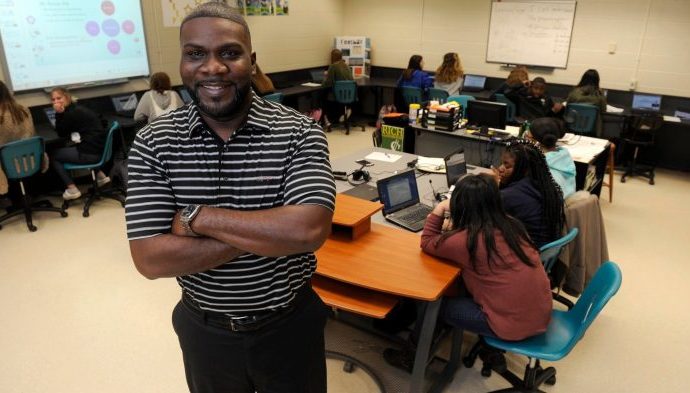Only two percent of teachers are black men, yet research confirms they matter
ByChandra Thomas Whitfield
Read the full article at theundefeated.com >
Cedric Jackson knows firsthand the impact that regular exposure to a positive black man can have on impressionable students — especially young black boys.
Back in the ’80s and ’90s, he was one of them, yearning to connect with male role models. After the death of Jackson’s mother when he was 8, his father sent him to live permanently with his aunt in a tough Huntsville, Alabama, neighborhood. Jackson said that while he was growing up, it was his black coaches and teachers, especially those at Lee High School, who took an interest in him, pushing the budding football star on and off the field.
“I had a tough life; I would go to school just to eat,” Jackson, now 40, recalled of his childhood. “Coming up, it meant the world to me knowing that I had these teachers and coaches in my corner. They had the biggest influence on me; they made me feel like I was somebody.”
He said that although he was not the most committed student academically, their investment paid off. With their encouragement, compassionate guidance and thought-provoking teaching, Jackson snagged the coveted quarterback spot on the Lee High Generals team. Just before graduation, the scholarship offers poured in.
Jackson ended up playing quarterback as a true freshman for historically black Alabama A&M University before transferring to and graduating from Midwestern State University in Wichita Falls, Texas.
At one point, Jackson said, he’d even caught the attention of Baltimore Ravens, Seattle Seahawks and Washington Redskins coaches, but his NFL aspirations were abruptly cut short when he injured his back while playing a pickup basketball game with a relative.
Distraught but thankful for his business administration degree, Jackson eventually took odd jobs as a substitute teacher, lunchroom worker and security officer at public schools in his home state. A gig as a special education teacher’s aide ultimately helped him discover his passion and natural talent for teaching. He answered the call, completing his licensure and a master’s degree in early childhood education online, all while working two full-time jobs and coaching. Now he’s a teacher and head football coach at Discovery Middle School in Madison, Alabama.
“My students know I’m going to push them. It doesn’t matter if they’re black, white or whatever,” he said. “I try to tell them about the things I’ve learned in life. They’re not looking for someone perfect, they just want someone who keeps it real.”
It’s not strictly anecdotal. A growing body of recent research asserts that Jackson’s presence as a black man in the classroom is both rare and critically needed in American public schools.
Since 2014, ethnic and racial minorities make up more than half of the student population in U.S. public schools, yet about 80 percent of teachers are white and 77 percent of them are female. People of color make up about 20 percent of teachers; a mere 2 percent are black men.
Most education experts agree that all students benefit from regular exposure to black teachers, and when present in schools, they are also often perceived as more approachable and voted most popular among students from all backgrounds. Still, the exceptionally low number of black men in American classrooms is not about winning popularity contests; many education experts assert it’s a matter of educational equity, or the lack thereof. It is well-documented that black students, who are regularly cited for lagging behind their white counterparts academically, actually perform better when taught by teachers of the same race.
“Kids do better when they’re taught by teachers who look like them. That’s just the way it is,” said California State University, Northridge (CSUN) education professor David Kretschmer, one of two directors leading the Future Minority Male Teachers Across California Project, known as F2MTC, which aims to recruit, prepare and retain male teachers of color at the elementary level throughout California’s university system. “That’s why we need more men of color in American classrooms, period.”
To his point, a groundbreaking 2017 study co-authored by a Johns Hopkins University economist found that having just one black teacher in elementary school significantly increased a low-income black student’s likelihood of graduating from high school and considering college; for a very low-income black boy, the risk of dropping out was reduced by 39 percent.
Jackson says he’s not surprised. When he’s not trying to build rapport with his students on the playing field as coach or in his career readiness and computer skills classes, he said, he attempts to do so by joking with them around campus. The interaction, he believes, helps them feel more positively about school, and they also tend to open up more about problems.
“I hate to say it, but as a black male teacher, you always kind of feel like you’re under a microscope, like you have to prove yourself,” explained Jackson. “I think having that experience helps make you a more approachable person [to students] in general. You know what it’s like to feel that pressure. All you want is the best for your students; you just want to see them succeed.”
Charles King says those same feelings of support and camaraderie he received from the many black men in leadership at his virtually all-black middle school in Atlanta in the mid-2000s set a strong foundation for his education. He said he didn’t fully realize the impact of having so many strong black male educators at KIPP WAYS Academy until he attended an affluent, predominantly white boarding high school in Rome, Georgia, where there were just a few black male teachers. King said his experience at both schools inspired him to earn a bachelor’s degree in middle grades education. Four years ago, he returned to his middle school alma mater as a teacher.
“I realized that I wanted my students to have access to the same resources that I had,” recalled King, 25, who teaches seventh-grade English. “I feel like I can connect with my students on a higher level because of our shared identity. I think they know — they can feel it — that I want the best for them. Being in the classroom is also a great opportunity for them to see a different version of a black man, the human side of a black man, and not the negative stereotypes that they usually see when they turn on the TV.”
King says he feels very supported at his school (the KIPP charter school network is well-known for its diverse teacher workforce). However, many black male teachers nationwide, especially where there are smaller numbers, say for them, not so much. Many report feeling isolated, passed over for decision-making positions and forced into disciplinary roles, particularly for students of color. Research has also found that black teachers are disproportionately clustered in under-resourced schools with fewer opportunities for mentorship and professional development, which often contributes to burnout and high attrition levels.
Vincent Cobb, Rashiid Coleman and Sterling Grimes are leading a Philadelphia-based program charged with changing that. The Fellowship: Black Male Educators for Social Justice was begun in 2014 with the objective of adding 1,000 black male educators, or “BMEs,” to city public schools by 2025. “We’re at 648; we started at 348,” said Coleman.
The Fellowship also hosts regional and national gatherings for black male teachers from across the country for networking opportunities and access to job fairs, mentorship programs and professional development.
“We’re here to let black men know that teaching is an opportunity to make a real difference, whether you live in a small town or a major metropolitan area,” explained Cobb, The Fellowship’s CEO. “Our kids are screaming out for help. We’re trying to spark a movement.”
The Fellowship is one of dozens of initiatives nationwide focused on recruiting and retaining black male teachers. For example, historically black Southern University of New Orleans’ Honoré Center for Undergraduate Student Achievement offers full scholarships in exchange for a two-year teaching commitment. With support from the W.K. Kellogg Foundation, the CSUN program will eventually expand its offerings to six urban campuses across California.
In New York City, Mayor Bill de Blasio’s administration launched NYC Men Teach in 2015 after data showed that 85 percent of public school students were racial minorities but 60 percent of those teaching them were white.
Arguably, the most well-known and long-standing initiative is Call Me MISTER at South Carolina’s Clemson University. Founded nearly 20 years ago, the program grooms black male high school students and teaching assistants for teaching careers, and it has since been expanded to other college campuses nationwide. Similarly, since 2017 the Washington, D.C.-based Branch Alliance for Educator Diversity program has partnered with historically black colleges and universities (HBCUs) to support black education majors.
“HBCUs must play a significant role in preparing black teachers who understand our community,” said Denise Pearson, project director for a State Higher Education Executive Officers Association collaboration with four HBCUs, focused on increasing minority male representation in the classroom. “We definitely need to be investing in our schools of education.”
Still, many education experts say getting more black men, and men in general, interested in teaching must begin with dismantling the stereotype that it’s “woman’s work” or merely a low-paying, low-reward career.
“There is always room for improvement, but salaries are rising,” said Lemuel Watson, dean of the school of education at Indiana University, who consults for the F2MTC initiative. “According to the American Association of Colleges of Teacher Education, or AACTE, teaching actually pays more than other ‘helping professions.’ So we have to change that mindset about teaching and salaries; however, they should be paid more for the value of their work.”
Rickey Wright, an assistant principal at Columbia High School in Decatur, Georgia, says pay is important but black men should also consider the power they would possess as teachers.
“To have 30 to 100 students observing your every move, every day, that’s a huge blessing,” he said. “You really get to help mold them into the people they need to be. That’s so important.”
Drew Martin, director of the KIPP Cooper Norcross Academy in Camden, New Jersey, said better retention of black male teachers must include providing much-needed support. Black men represent about 13 percent of the teaching workforce at KIPP’s 11 New Jersey schools, which is about six times higher than the national average. He attributes much of that success to a Teacher In Residency program at many KIPP schools that pairs a new teacher with a “high-performing” veteran teacher for mentoring.
“It’s a complicated issue, and there’s no one way to fix it, but we do know that it will not get addressed if it’s not treated as a priority,” he said. “School districts must send a message from the top that teacher diversity is important.”
Frank Lee, a black English language learner instructor at an alternative school in Colorado Springs, Colorado, agrees. He says it is up to members of the black community to step in and sign up to become teachers. It’s the only way, he said, to ensure that black children — and all children — receive a quality education.
“Filling that void, that gap, in the teaching field is so crucial,” said Lee, 31. “As black men, we have real power to make an impact.”
Perhaps King sums it up best:
“Black male teachers matter because our kids matter,” he said. “Our kids are brilliant, and we’re the ones who are best equipped to pull it out of them.”
The Undefeated contributor Chandra Thomas Whitfield completed this report and accompanying video with support from the Education Writers Association Fellowship program.
